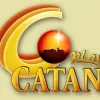Take a look inside 4 images
Play Catan
Pros: Bright iconography and automated calculations help experienced players move quickly through the game.
Cons: Insufficient tutorials and a quick pace limit accessibility to new players.
Bottom Line: It's an okay browser-based translation of a great board game that can yield some engaged learning of probability and social studies with creative teacher support.
Teachers can use Play Catan to help kids build basic background knowledge about colonization, conflict, economics, and exploration, but both the iOS app and the original board game -- the gold standard -- are better starting places for kids. Play Catan is sometimes helpful as a teaching tool because of what it leaves out of the game. For example, because Play Catan doesn't include or reference native peoples or let players directly wage war on one another, teachers can ask students to compare and contrast how they play the game with how peoples and nations have behaved toward one another over time. There is a lot of room to think critically about Play Catan's depiction of settlement and colonization, and students can launch into knowledge and empathy building research projects that fill in some of the gaps left out by the game.
Play Catan is a fast-paced, online adaptation of the popular board game Settlers of Catan, where players act as colonists of a new land, vying for limited resources. After an initial round where players place two settlements and roads (trying to jockey for ideal position) on the board, they spend the rest of the game cooperating and competing with one another to build settlements and roads so they can gather the resources -- and victory points -- they need to gain influence and control. It's one of the best board games of all time, but this version is tough to integrate into classrooms. Kids can play online tutorials or host or join multiplayer games online, but a dated interface makes it hard to create or find games suitable to kids to play. Some games allow chat, while others don't. It's difficult to group students together, and each student needs an email address to register for the site. Quick, text-based tutorials introduce most of the game's key concepts, but they are not very deep, interactive, or welcoming for new players.
Play Catan is fun for kids who already know how to play, but even those kids will need help connecting the game to class content. A teacher acting as a guide-on-the-side can do a lot to help kids compare and contrast what happens in the game to what has happened throughout history as people have explored new lands, coveted resources, and entered into cooperation or conflict with one another. Since using mathematical probability to one's advantage is also key to victory, Play Catan serves as a great platform for kids to practice mathematical thinking.











